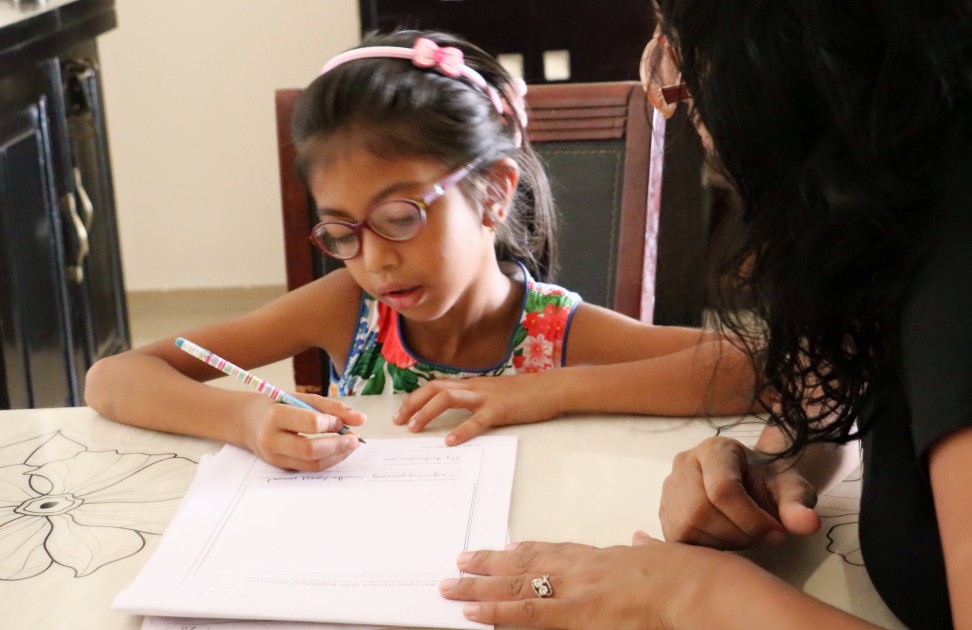What Teletherapy Is and Why It Works
written by Liza Bennigson, Associate Director of Marketing and Communications
 In the early days of the pandemic, CHC implemented a remote model of care using a HIPAA-compliant healthcare platform on Zoom so that our nonprofit mental health agency could continue to deliver best-in-class support to kids, teens and young adults with learning differences and mental health concerns.
In the early days of the pandemic, CHC implemented a remote model of care using a HIPAA-compliant healthcare platform on Zoom so that our nonprofit mental health agency could continue to deliver best-in-class support to kids, teens and young adults with learning differences and mental health concerns.
Since then, we’ve learned a few things. Namely, that teletherapy (telehealth therapy) works, and it’s here to stay. In this article we’ll dive into what teletherapy is, why it works, and how it has allowed us to expand access to services.
A study published in the Journal of Psychological Disorders found that online cognitive behavioral therapy was equally as effective as face-to-face treatment for major depression, panic disorder, social anxiety disorder, and generalized anxiety disorder. Studies conducted across five different countries confirm that a strong therapeutic alliance can be developed through telehealth sessions.
“What we’ve seen is that telehealth is essentially just as effective as face-to-face psychotherapy — and retention rates are higher,” says David Mohr, PhD, director of the Center for Behavioral Intervention Technologies at Northwestern University’s Feinberg School of Medicine, who has spent his career studying telepsychology and digital mental health.1
Teletherapy: Therapy, Redefined.
Like many organizations who pivoted during the pandemic to offer services remotely, CHC quickly realized that its value is not confined to physical buildings (despite bright, welcoming waiting rooms). It’s all about the people: the brave families who would do anything to help their one-of-a-kind kids overcome obstacles to reaching their full promise and potential, and the passionate experts supporting them every step of the way.
What took a little longer to realize was that, from the safety of clinicians’ homes and comfort of clients’ couches, a sort of magic was happening. As restrictions were put in place all around us—no school, no sports, no parks, no toilet paper—teletherapy was removing barriers, providing unprecedented access to people’s lives as they lived them.
What, Exactly, Is Teletherapy?
Teletherapy (also known as telehealth or online therapy) is a form of mental health counseling or therapy that is conducted remotely, typically using digital technology and the internet. It allows individuals to receive therapy services from the comfort of their own homes or other convenient locations.
Teletherapy can be an effective way to receive support and treatment for mental health concerns when in-person options are not feasible or preferred.
Why Teletherapy Works
You know that feeling you get after an eye-opening meeting with your mentor, life-affirming session with your therapist, or aha moment conversation with a friend? How you just wish you could bottle up their advice and take it home with you, or record everything they say to revisit when you need it most?
Just as Supernanny swooped in to tackle tantrums and sleep training on the spot, teletherapy offers families the help they need in real-time, on their home turf. It allows access to other members of the household, facilitating live parent coaching and sibling interventions. Many kids are more relaxed at home, sporting pajamas, showing off their Lego sets, leading virtual home tours, and introducing favorite stuffies. Dogs, cats, bunnies and lizards instantly become therapy animals, easing tensions on-screen. Clever Zoom backgrounds serve as ice breakers and exposure therapy. By accessing teletherapy from the privacy of home, masks can be removed, both literally and figuratively, leading to greater expressiveness and human connection.
CHC’s Teletherapy— in Real Life (IRL)
CHC’s whole-child, multi-disciplinary approach features experts from a variety of fields working together to provide comprehensive and customized care for kids, teens and young adults. Here are some of the ways CHC experts have been leveraging teletherapy to collaborate with families to support their clients in meaningful and sustainable ways.
Individual Therapy
Now more than ever, kids, teens and young adults need to feel like they have a safe space to just be themselves. For many, being in familiar surroundings rather than in a clinical office allows them to feel much more comfortable, open and communicative. They can give their clinician a glimpse into their everyday life, whether that be sharing their favorite possession, showing off their relaxation corner, or complaining about their sibling who keeps interrupting. All of these opportunities exist because our clinicians have been able to transport themselves into their worlds, which is incredibly powerful in our more disconnected and socially distanced lives.
Seeing young people on their home turf also allows for some of the most realistic opportunities to practice some of the strategies they are learning in therapy. Afraid of germs in the bathroom? Your clinician can accompany you to your home bathroom when doing exposure therapy to reduce your anxiety. Having angry outbursts at a family member who is always in your space? Your clinician can work with you to de-escalate the situation and problem-solve with your family member in the moment. Unable to get started on your homework? Your clinician can help you identify incentives in the home that help get you off the starting line. Individual therapy is no longer confined to the limited array of conversation starters in a clinician’s office.
Family Therapy
When one member of the family is struggling, the whole family struggles. Teletherapy can help improve communication and family dynamics by bringing an impartial clinical expert into the equation, helping resolve issues like shifting roles, sibling conflict, marital tension and family stress, sometimes even as they occur. As we all spent more time with our families over the course of the pandemic, perhaps more than perhaps ever before, we learned that teletherapy helped nurture healthy change and development at home.
Group Therapy + Support Groups
Sometimes we need to vent about the people we love most. It’s normal and healthy to share grievances, ask for help, and support others who are having a hard time. Parent and peer groups are ideal settings for these conversations and many of us miss the ability to interact with people going through similar challenges. Using teletherapy, we can connect with others from the safety of our own homes. In a group setting, we can find guidance and acceptance from people who understand and realize that we are not alone.
Even the most at-risk teens with suicidal and self-harm thoughts and behaviors were able to seamlessly access comprehensive DBT services through the RISE Intensive Outpatient Program, featuring a collaboration of experts from CHC and Stanford Children’s Health. During shelter-in-place, the program was fully operational via teletherapy, allowing it to expand its borders beyond the Bay Area to serve teens and families that wouldn’t otherwise be able to attend 4-day/week live sessions in Palo Alto. (Today, RISE operates via a hybrid telehealth/in-person model.) Thus, teletherapy has helped more teens build lives worth living and avoid ER visits and hospitalizations during the pandemic and beyond.
Meanwhile, a record number of parents are accessing CHC’s online support groups, classes and coaching to help ease anxieties around responding to children’s challenging behavior, supporting teens, and setting more realistic expectations for their kids (and themselves). CHC’s Parent Support Groups are growing, and we offer a Voices of Compassion podcast series that features CHC experts weighing in on a wide range of timely topics. By allowing audiences to access rich and engaging content from home, we can reach many more people in a far greater radius. The most important message? You are not alone.
Support + Self-Care
For over a year, many of us didn’t have access to teachers to pull us aside at pickup to tell us they noticed concerning behavior from our child, or staff members who saw our child being bullied on the playground, or a coach emailing us about our child skipping practice, or even our child’s friends sharing the latest drama during carpool. “At CHC, we believe in the promise and potential of every child as well as the capacity and innate strength of every parent,” says Dr. Ramsey Khasho, Chief Clinical Officer. “But in order for us to thrive, we need a village, and to learn how to tap into that village in new and innovative ways.”
Executive Functioning
Teletherapy allows therapists to remotely offer encouragement, executive functioning coaching, and mindfulness strategies.For example, a CHC therapist recently coached the parents of an 8-year-old to create a daily timeline to help her track and manage her own schedule, boosting confidence and fostering independence. By breaking down actual assignments into manageable chunks, students learn organization, time-management and how to ask for help.
SEL
After the disruption many students experienced with remote learning and sheltering-in-place, teletherapy helped children, teens and young adults regain important life skills like empathy, creativity, patience, flexibility, frugality, responsibility, simplicity, gratitude, tolerance, compromise and mindfulness. Teletherapy is an invaluable tool to facilitate SEL development while coping with stressors.
Occupational Therapy
Teletherapy also opens new doors for Occupational Therapists (OTs). What better place to teach kids how to share space and set boundaries than at home? OTs have been partnering with parents to utilize household items for visual motor integration, create obstacle courses to enhance gross motor skills, transition away from screen time, incorporate chores into sensory-processing activities (e.g., meal preparation, folding laundry, taking out trash, cleaning, etc.), establish bedtime routines, regulate emotions, practice social skills and control impulses through turn-taking games. For example, a CHC therapist recently guided the parents of a 5-year-old to make a yarn maze in the living room to practice directives like “step over” and “crawl under.”
Speech and Language Therapy
Speech and Language Practitioners (SLPs) have been making breakthroughs via teletherapy by helping families create optimal home environments to account for auditory processing challenges and other modifications normally used in the classroom (e.g., quiet study areas, processing and repeating directions, comprehension checks). SLPs have also advised families on how to implement IEP goals; promoted social skills by facilitating online playdates or hangouts; incorporated speech and language goals like articulation, inferences and summarization into the client’s academic program; provided visual supports to help students stay on task; and built confidence and communication skills to prompt students to ask for help.
SLPs can virtually consult with teachers to discuss ways to break down assignments for learners with diverse needs, and suggest books, videos and games for families to reinforce specific goals. SLPs can also provide weekly parent consultations to share strategies and activities to practice the client’s goals within the parameters of existing structures and routines. Most importantly, assignments can be customized to reflect each client’s interests. A CHC SLP recently helped the parents of a 5-year-old incorporate nature vocabulary and concepts into family hikes. Another CHC SLP encouraged the parents of a 4.5-year-old to use a remote control toy as a means for the child to practice alerting his parents and siblings about obstacles the toy might hit.
Medication Management
For clients considering medication or experiencing significant dysregulation, seasoned adolescent and child psychiatrists can prescribe and manage medication needs via telehealth without additional trips to the office.
The Future of Therapy?
At this point, many CHC clients have opted to return to in-person therapy and experience that human connection face-to-face. But teletherapy may have forever changed the therapy experience for others. “For those who don’t live anywhere near a trusted clinician, can’t get an appointment at their local practice, want to work with a bilingual or culturally-relevant therapist, lack transportation, work long hours or have vulnerable teens going off to college in other cities, teletherapy can open doors and offer hope,” adds Dr. Khasho. “And isn’t that what we’re here for, after all?”







